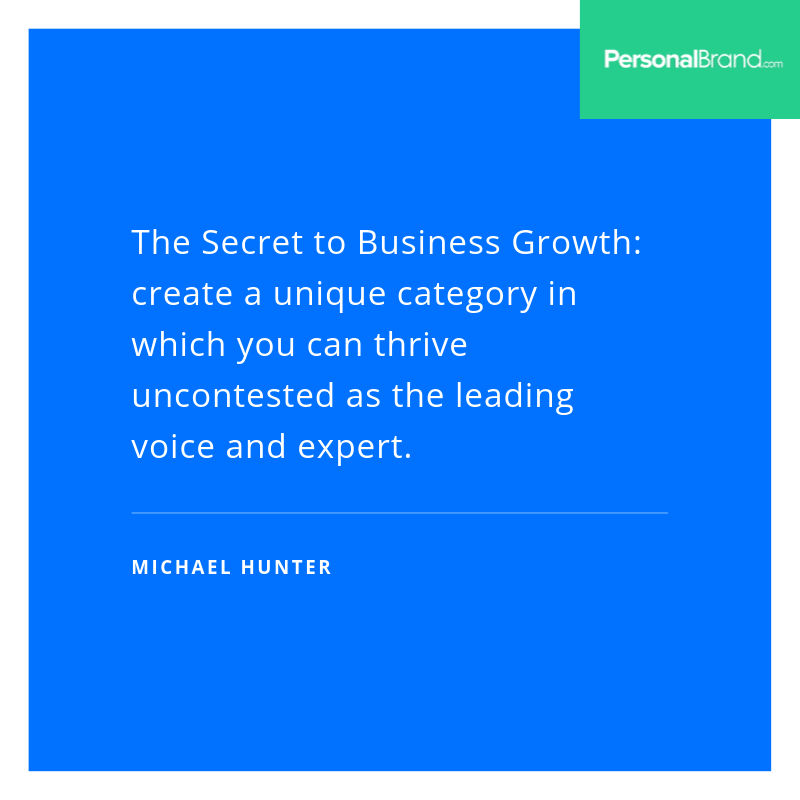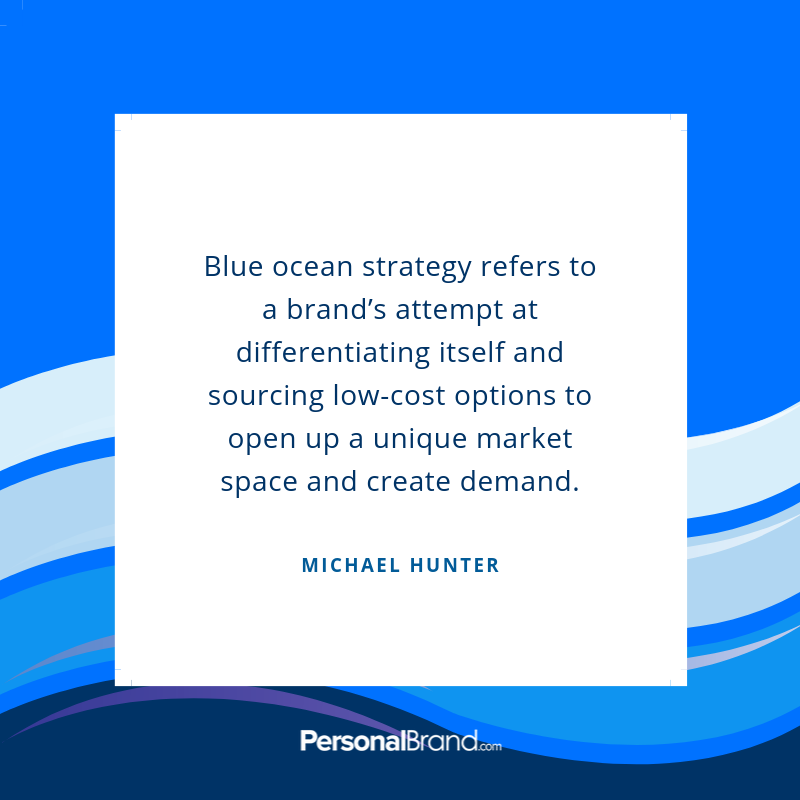Some people are simply electrifying.
We’ve all had that moment where we walk into a crowded party, and we immediately notice the one person who has the whole room engaged. They aren’t necessarily the loudest or the flashiest.
They are simply the most compelling—the most intriguingly authentic.
The most successful personal brands are just like these alluring party guests. They stand out from the competition and make those exposed to their charm want to learn more and be inside their inner circle.
No matter your industry or offering, if you’ve been searching for a way to make your personal brand stand out, we have five strategies to help you reach your goal, inspired by W. Chan Kim and Renée Mauborgne’s book, Blue Ocean Strategy.
5 Strategies to Differentiate your Personal Brand
Preliminary Framing: Understanding Red Ocean vs. Blue Ocean
The premise of Kim and Mauborgne’s acclaimed strategy guide centers around the idea of differentiation.
Blue ocean strategy refers to a brand’s attempt at differentiating itself. That, and it’s about how they source low-cost options to open up a unique market space and create demand.
The goal in a blue ocean strategy is to develop and capture uncontested market share, all but eliminating the competition.
For example, Uber competes today with Lyft in the ride-sharing space, but when it first entered the market, it did so by creating an innovative concept for which there was no competition. Uber dominated until its first real competitor came along. During that time, Uber was in a blue ocean (think calm, blue seas).
On the opposite side of the spectrum from a blue ocean strategy lies a red ocean—a market space full of competition and brands all battling one another for survival (think blood in the water).
Red Ocean is marked by crowded and competitive market spaces, where growth and profit opportunities are restricted, services and solutions are commoditized, and brand acceleration is stifled.
If you’re looking to grow your personal brand from six to seven figures, the goal is to differentiate yourself in a way that creates a unique category in which you can thrive uncontested as the leading voice and expert.
To execute a blue ocean strategy for your brand, first, read Blue Ocean Strategy—it’s an inspiring book. Also, follow these five tips to differentiating your personal brand by creating new market segments.
1.Start with the Why
Theodore Levitt, the American economist, and Harvard Business School professor taught us that
“People don’t want to buy a quarter-inch drill. They want a quarter-inch hole.”
One of the most memorable a-ha moments in marketing education history, Levitt’s comments remind us all that people don’t want to buy services or products. They want solutions.
They don’t want a life coach. They want to be more successful and feel more fulfilled.
They don’t want to take a public speaking class. They want to accomplish the training elements of their job requirements without crippling fear and discomfort.
When looking to differentiate your personal brand, think long and hard about why you do what do you, and the solution—not the service—that you are offering your prospects.
Deeply assessing the why will help illuminate problems your prospects may not know that they have. This helps you to differentiate your personal brand by exposing a marketplace need.
Think, for example, about the personal brand leader, Japanese organizing consultant, and author Marie Kondo. Thousands of words and hundreds of guides about home organization were published before Marie Kondo entered the marketplace. However, what sets her apart, is her why.
Marie realized that people were holding onto possessions out of sentimentality. By illuminating that issue, and helping people to accept that it’s okay to let something go that no longer gives you joy, she immediately brought the world a perspective it didn’t even know it needed. It simultaneously launched her personal brand into the stratosphere.
2. Evaluate Substitute Offerings
Too often, when launching or growing a personal brand, entrepreneurs focus on differentiating themselves from their direct competitors.
Faith-based motivational speakers look to other religious speakers to identify ways to achieve competitive recognition and success. Similarly, life coaches look to others in their industry—perhaps those to whom they have lost prospective clients—to find ways to offer a more compelling offering.
When evaluating the competitive landscape, too often, entrepreneurs fail to consider their indirect competitors or those substitute offerings that are available to their prospects.
Frequently, such assessments can help to lend clarity to the gaps in the marketplace and help you to identify new market segments—those blue ocean opportunities—in which you can excel as the dominant leader.
Bonus Ninja Tip: A SWOT analysis can help you with direct and indirect competitor assessments.
Consider, for example, the market share challenges of a fitness expert who has created a series of at-home fitness workouts that he is attempting to launch into the marketplace. Initially, he may be strategizing how to compete with such market leaders as Tony Horton’s P90X® program or Billy Blanks’ Tae Bo® fitness solutions. What he may fail to consider, are the alternative or substitute offerings that are available to his target audience, such as local gyms, at-home personal trainers, fitness classes, and home gym equipment. A more in-depth assessment of all the options available to prospects may elucidate a realization of an underserved market segment.
For example, the reason why people choose at-home fitness programs may be that they are low-cost, low-investment, equipment-free, and can be done at home. These qualities make them more accessible for those with busy lifestyles. What individuals who choose gyms, trainers, or fitness classes lose by choosing an at-home fitness program, is the sense of community that comes from working out with others.
Peloton®, for example, has created a new market segment by offering a convenient at-home equipment solution. They provide a community aspect by allowing users to take a live class while never leaving their home.
Could our hypothetical fitness expert find a similar, underserved niche to differentiate himself from the existing at-home fitness program leaders? Yes—and the key just may come from deeply exploring substitute offerings.
3. Find Your Unique Voice
People don’t buy from companies. They buy from people.
The unique opportunity that personal brands have over corporate brands is their ability to connect with their customers on a deeply personal level.
Oprah Winfrey, for example, has achieved epic levels of personal brand greatness. Why? Her viewers and fans feel that they have a relationship with her. She is not just a talk show personality. She is a trusted friend and guide whom they welcome into their home through her television interviews, books, and magazine. She is larger than life and entirely authentic.
Just saying the name Oprah elicits an image of her smile and the sound of her voice. We can all imagine Oprah magnanimously telling us, “You get a car, and you get a car, and you get a car!” While we can imagine hearing her voice, it’s not its cadence or tone that resonates with us. Rather, it’s the uniquely authentic aspect of what has made Oprah relatable and beloved that we think about when we reflect on her personal brand.
There will never be another Oprah, but you too can establish a voice that is unique, relatable, and that makes your prospects want to work with you. Finding your voices is all about understanding your personal brand’s value proposition and understanding how to let your authenticity shine through. More on that here.
4. Validate Your Suspicions
If you already have a service or solution idea that you feel is uniquely differentiated, let the market tell you if you’re right.
Get out of your office and your head and talk to your prospective target audience. Qualitative research is an art and a science, but if your idea truly meets an underserved marketplace need, make sure you don’t ask questions about your services.
Ask questions about your prospects’ needs.
Many of us are subconscious people pleasers. Simply asking someone if they would be willing to try your new offering may elicit an easy ‘yes’ out of a subconscious desire to tell you what you want to hear. Instead, ask questions that focus on whether or not your offering would meet the need you identified. Identify why or why not.
For example, if you ask, “Would you subscribe to a 60-day life coaching plan that would help you get a raise at work by the end of the two months?” Most people would undoubtedly say ‘yes’.
However, if what your plan actually offers is training on how to pitch the reasons why you deserve a raise with confidence, focus instead on the reasons why people don’t ask for a raise. Some of those reasons include fear, feeling undeserving, and being unsure how to position their accomplishments. If those reasons are truly holding people back, your 60-day plan will serve their needs.
5. Be Consistent with Your Go-to-Market Messaging
If you are launching a completely new, unrivaled concept or service, you will need a compelling way to explain to your target audience what you are offering and why they need it. Further, you’ll need to keep in mind that such a new concept is going to take some explaining.
Think about ride-sharing scooters, for example.
Never before was there an option to use an app to rent a publicly available scooter for one-time use—like renting a library book.
When Bird launched its dockless electric scooter sharing company in Los Angeles, a city known for horrendous traffic and limited public transportation options, it needed to clearly brand itself in a way that conveyed the problem it was solving.
The problem they were solving was the issue of commuting a short distance inexpensively and conveniently, through a one-time transportation tool.
They had to articulate this to the previously unrealized market segment, including people who need to get around in a place without convenient public transportation, driving, and parking.
Today, Bird’s message is clear. Bird positions itself as “A reliable last-mile electric scooter rental service, whose mission is to make cities more livable by reducing car usage, traffic, and congestion.”
Final Thoughts
Once you have validated a market segment need, and understand your unique voice, position your personal brand in a way that communicates what you are offering, why, and its benefits.
There will never be another you.
Your voice, your ideas, your innovations, and your commitment to your customers are unparalleled.
To be the best, you have to showcase why you do what you do, understand your target market’s needs, assess the competition, own your voice, and explain your purpose.
Do all these things, and you’ll be backstroking in calm, blue ocean waters in no time.
![]()
We hope you enjoyed this article, thanks for reading! Also, follow us on Facebook, and Twitter for updates every time we publish!






